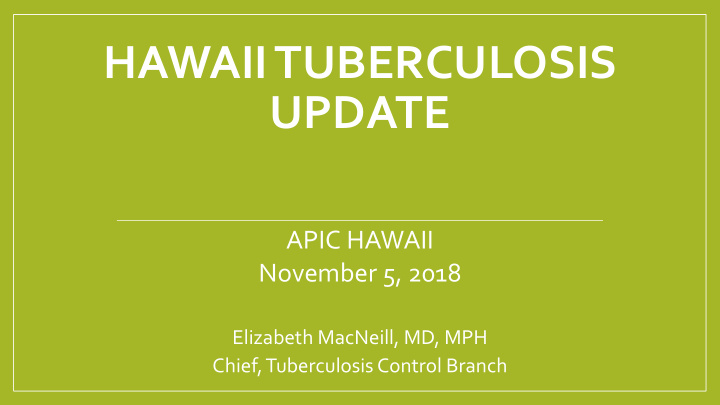



HAWAII TUBERCULOSIS UPDATE APIC HAWAII November 5, 2018 Elizabeth MacNeill, MD, MPH Chief, Tuberculosis Control Branch
Reported TB Cases Hawaii, 1930 – 2016 1200 1060 1000 No. of cases 717 800 600 339 400 293 270 196 167 200 136 119 136 117 115 0 Year 1930 1940 1950 1960 1970 1980 1990 2000 2010 2012 2014 2016 Updated as of May 1, 2017
Trends in TB Cases and Percentage of Foreign-born Persons (Hawaii vs. CDC Definition) No. of Cases Percentage Hawaii, 2007 – 2016 140 100% 90% 120 80% 100 70% 60% 80 50% 136 127 124 123 122 60 119 117 117 115 115 40% 30% 40 20% 20 10% 0 0% 2007 2008 2009 2010 2011 2012 2013 2014 2015 2016 No. of Hawaii Cases Foreign-born (Hawaii Definition) Foreign-born (CDC Definition) Updated as of May 1, 2017
Hawaii Pediatric TB Cases by Birth Country, 2007-2016 Guam Burundi 3% 3% Marshall Islands 14% United States 54% Age ≤14 FSM 13% n=37 Philippines 13%
Parent/Guardian Country of Birth Among US-Born Pediatric Cases, 2007-2016 Vietnam Philippines 5% 8% n=36 Guardians among Marshall Islands 20 US-Born Cases 17% 90% of US-Born Pediatric Cases have at Least One non-US Born FSM Parent/Guardian 47% United States 17% Tonga 3% American Samoa 3%
Percent of Foreign-born TB Cases by Time of Residence in U.S. Prior to Diagnosis Hawaii, 2016 100% 90% 80% 70% 60% 50% 40% 30% 20% 10% 0% Vietnam Federated Philippines Japan China Other All Foreign- States of born Micronesia Unknown* <1 1-4 ≥5 *Foreign-born TB cases for whom information on length of residence in the U.S. prior to diagnosis is missing or unknown Updated as of May 1, 2017
Risk Factors for TB Exposure All Hawaii TB Cases, 2012-2016 Foreign-Born 87% Occupational Risk* 4% Known Contact to MDR-TB Case 0.3% n=614 Known Contact to Infectious TB Case 7% Homeless within the Past Year 5% Resident of Correctional Facility 0.3% Resident of Long-Term Care Facility 2% Lived Outside the US > 2 Months 0.3% Other Exposure or Progession Risk 13% No Known Risk Factor for Exposure 6% 0% 10% 20% 30% 40% 50% 60% 70% 80% 90% 100% *Occupational Risk: Health Care Worker, Migrant/Seasonal Worker, Correctional Facility Employee Percent with Risk Factor
Risk Factors for TB Progression All Hawaii TB Cases, 2012-2016 Diabetes History or Positive Diabetes… 57% TNF-Alpha Use 0.5% Incomplete LTBI Treatment 5% Excess Alcohol Use 10% n=614 Any Drug Use 2.0% HIV Positive 0.3% Immunosuppression 4% Post-Organ Transplant 0.2% End Stage Renal Failure 3% Other Exposure or Progression Risk 13% No Known Risk Factor for Progression 26% 0% 10% 20% 30% 40% 50% 60% 70% 80% 90% 100% Percent with Risk Factor
Primary Anti-TB Drug Resistance * Hawaii, 2007 – 2016 25% 22% … 20% % Resistant 15% 13% (12) 12% (12) 12% (11) 10% (9) 10% 9% (7) 7% (6) 6% (6) 5% (5) 4% (4) 5% 3% (3) 1% (1) 1% (1) 1% (1) 1% (1) 1% (1) 0% (0) 0% (0) 0% (0) 0% … 0% 2007 2008 2009 2010 2011 2012 2013 2014 2015 2016 Isoniazid MDR TB * Cases are culture positive with initial drug susceptibility testing done. Isolates may be resistant to other drugs. Excludes cases with susceptibility testing not done or unknown for isoniazid and rifampin. Updated as of May 1, 2017
New Trend? • 70 year old woman • Foreign born • 5 prior, unsupervised TB treatments in at least 3 countries • % uncompleted? • Last US treatment in 1991: Resistant to INH, Strep. Private treatment with INH, Rifampin, Ethambutol and Capreomycin. Lost to follow-up. • Now: Resistant to INH, EMB, PZA, Amikacin, Ofloxacin. Rifampin???
The Future for TB Control Active Disease Control : • Faster and more complete test results: PCR, MDDR, WHS DOT for all patients Increase surveillance for at-risk settings Genotypic clusters For Latent TB Infection • Focused testing and more specific testing Increase/improve patient education Work with agencies who serve at-risk groups New Guidelines for healthcare staff screening? •
Recommend
More recommend